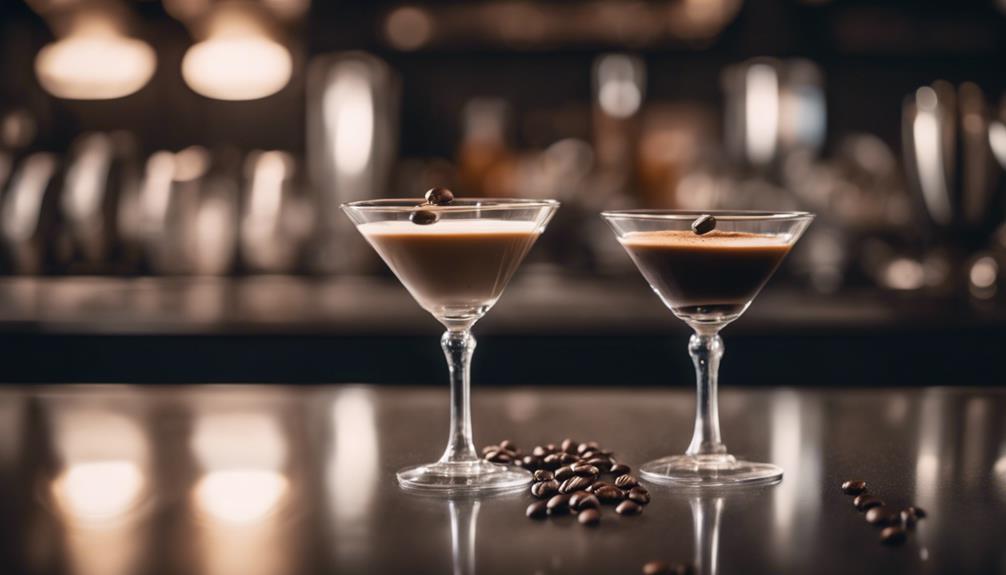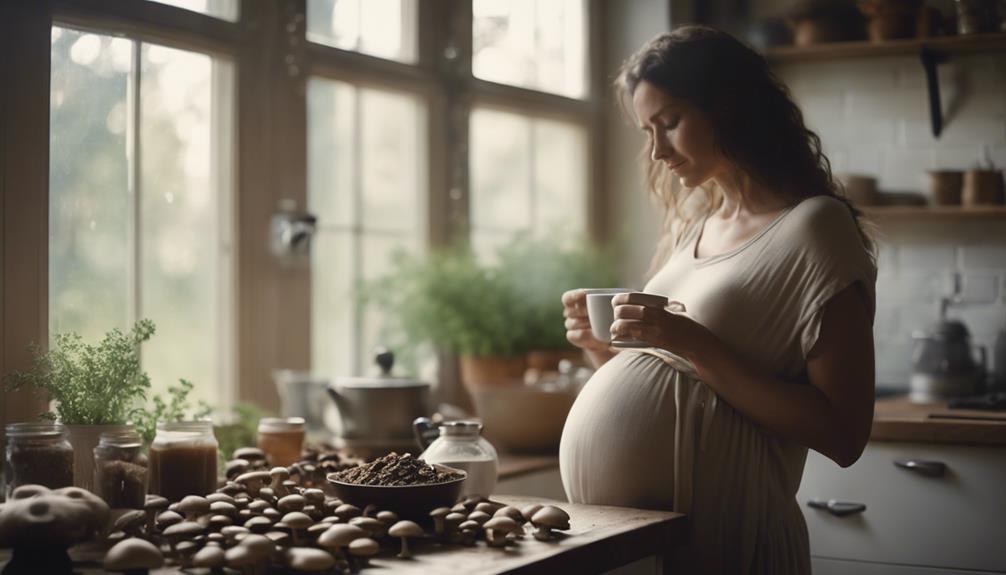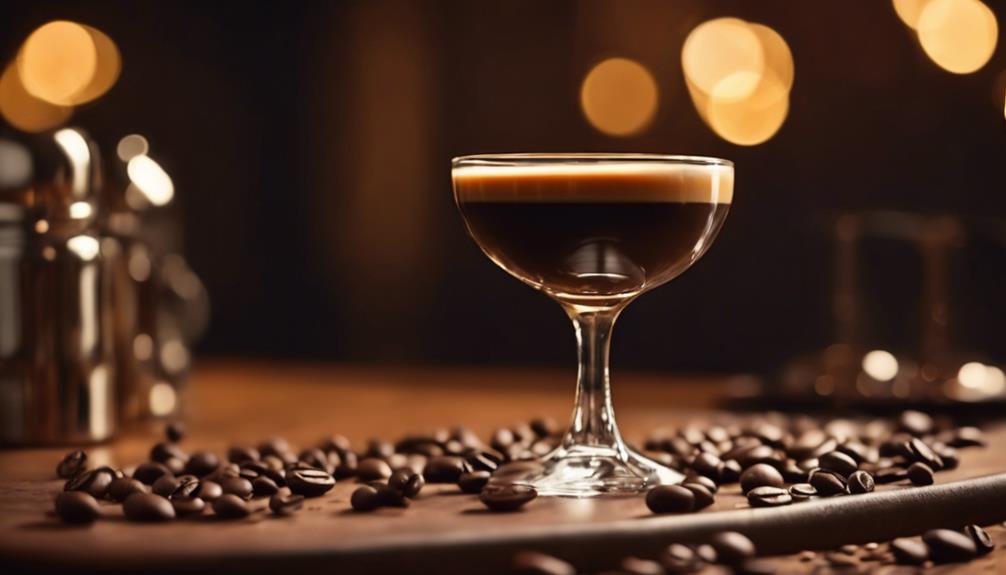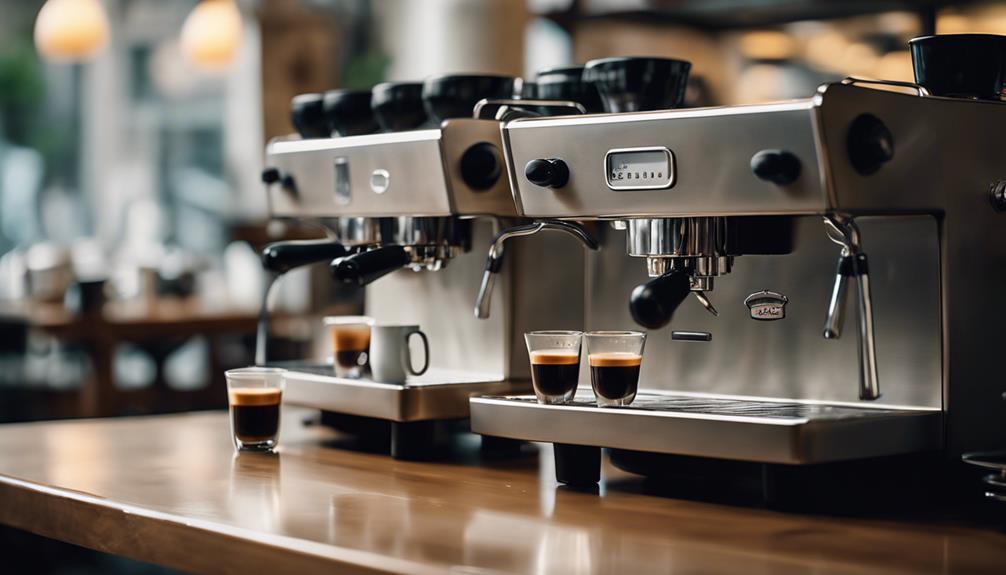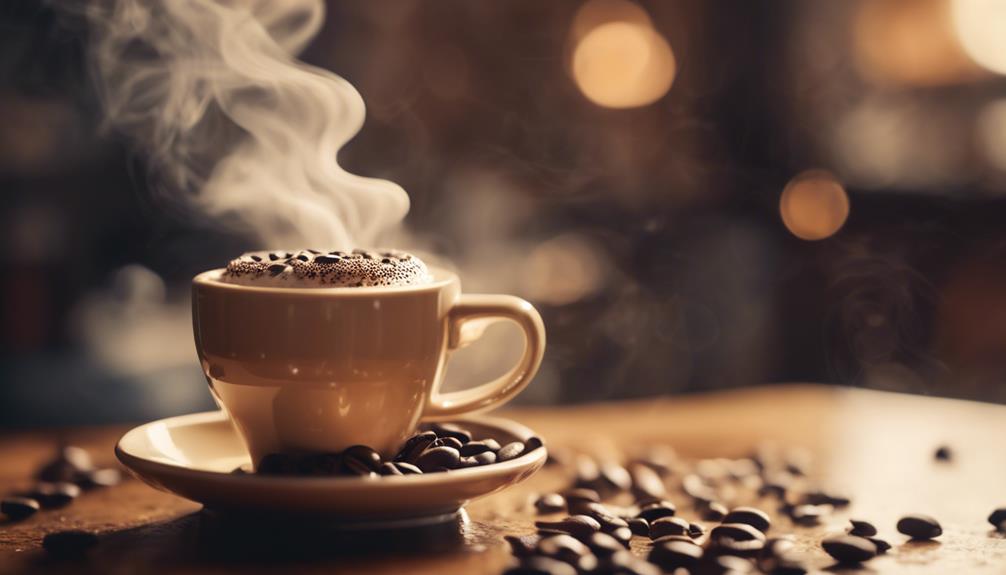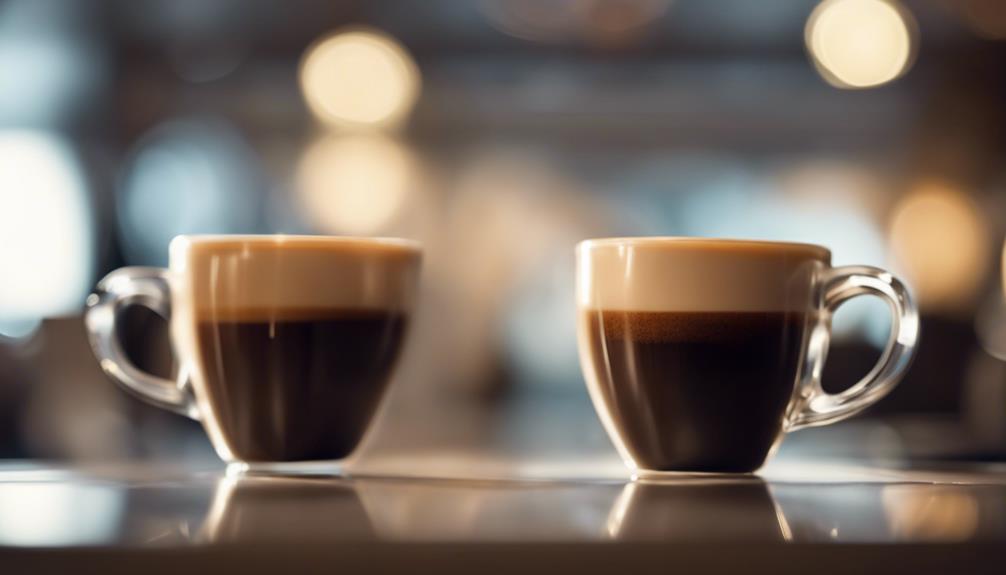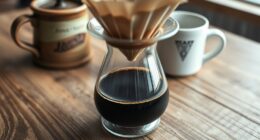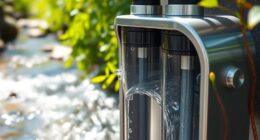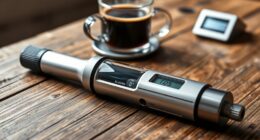You are on the verge of experiencing the ultimate combination of rich espresso and smooth vodka in a classic cocktail that is both sophisticated and indulgent. To make the original Espresso Martini, you will need 2 oz vodka, 1 oz freshly brewed espresso, 1 oz coffee liqueur, and 0.5 oz simple syrup, along with a cocktail shaker and jigger. Brew your espresso shot using freshly ground coffee beans, then vigorously shake all the ingredients with ice for 60 seconds. Pour into a chilled coupe glass and garnish with three coffee beans. With these key components, you are on your way to enjoying this intricate, creamy delight – and there is even more to discover beyond this flawless mix.
Key Takeaways
- Use 2 oz vodka, 1 oz freshly brewed espresso, 1 oz coffee liqueur, and 0.5 oz simple syrup for an authentic flavor.
- Freshly brewed espresso is essential; use it immediately after brewing for the best taste.
- Shake the cocktail vigorously for 60 seconds in a shaker filled with ice to achieve a frothy texture.
- Strain the mixture into a chilled coupe glass and garnish with three coffee beans for a elegant touch.
Essential Ingredients and Equipment
To craft the perfect Espresso Martini, you'll need a few essential ingredients and tools within arm's reach.
This classic cocktail requires 2 oz of vodka, 1 oz of freshly brewed espresso, 1 oz of coffee liqueur like Kahlua, and 0.5 oz of simple syrup. Freshly brewed espresso is vital for an authentic flavor, so use it immediately after brewing for the best results.
You'll also need a cocktail shaker to mix the ingredients and achieve the desired frothy texture through vigorous shaking. A jigger or measuring tool is necessary to guarantee accurate measurements of the ingredients for consistent flavor in each serving.
With these ingredients and tools, you'll be well on your way to creating a delicious Espresso Martini. If you prefer a dairyfree option, simply substitute the dairy cream with a non-dairy alternative such as coconut cream or almond milk. This will give your Espresso Martini a rich and creamy texture without the use of dairy products. With this simple modification, you can enjoy a delicious dairyfree espresso martini recipe that is just as delightful as the traditional version. Whether you choose to go dairyfree or stick with the classic ingredients, you’re sure to impress your guests with your cocktail-making skills.
Brewing the Perfect Espresso Shot
You're about to reveal the secret to a flawless espresso shot by focusing on the right coffee beans, grind, and brewing technique.
Start with freshly roasted coffee beans, ideally ground just before brewing, to guarantee maximum flavor extraction.
Use an espresso machine to maintain the required pressure of 9 bars during extraction, which is essential for achieving a rich and creamy shot with a foamy crema on top.
Aim for a brew time of approximately 25-30 seconds, allowing for ideal flavor extraction while avoiding bitterness.
Get the coffee-to-water ratio right by using around 18-20 grams of coffee for a double shot (about 36-40 ml). This will give you a balanced and flavorful espresso.
Don't forget to preheat your espresso machine and cup to guarantee that the shot maintains its temperature and quality from start to finish.
By following these guidelines, you'll be well on your way to brewing the perfect espresso shot.
With practice, you'll be able to consistently produce a shot that's rich, creamy, and full of flavor.
Shaking and Serving Perfection
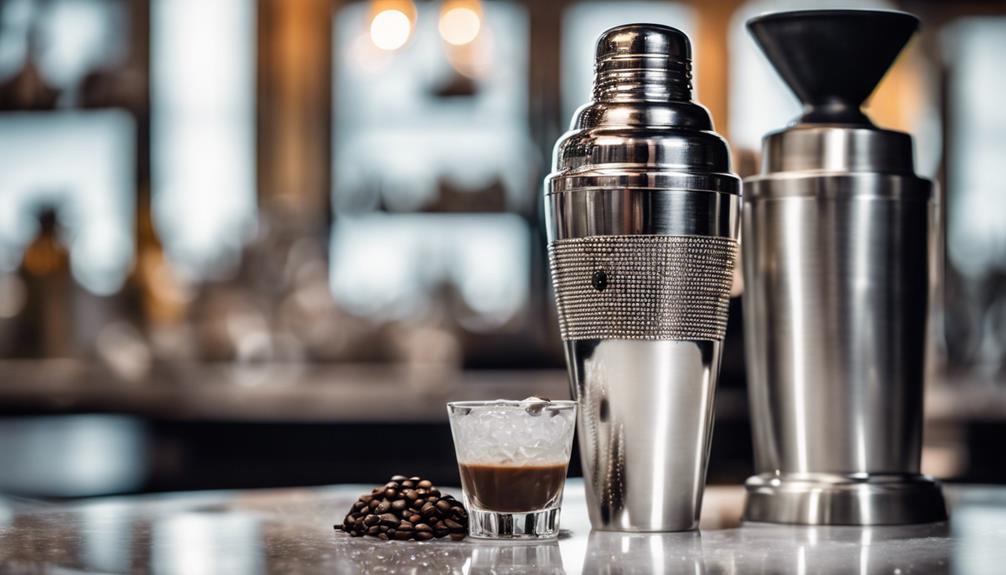
With your perfectly brewed espresso shot in hand, it's time to shake things up and create a velvety-smooth Espresso Martini that's as visually stunning as it's delicious.
To do this, you'll need to shake the cocktail vigorously for a full 60 seconds in a cocktail shaker filled with ice. This guarantees proper foam formation and a silky texture on top, giving your martini a frothy finish.
Once you've shaken the mixture, strain it into a chilled coupe glass to maintain the drink's temperature and enhance presentation.
The final touch is to garnish with three coffee beans on top, adding an elegant touch to the drink.
Now, serve the Espresso Martini immediately after preparation to enjoy the best flavor and texture. Remember, the foam can diminish if left to sit, so don't wait – serve and savor!
With these steps, you'll be enjoying a beautifully crafted Espresso Martini that's sure to impress.
Tips for Customization and Variations
Now that you've mastered the original Espresso Martini recipe, it's time to get creative and make it your own by experimenting with unique flavor combinations and twists. As a coffee lover, you can take your Espresso Martini to the next level with these customization tips.
| Variation | Description |
|---|---|
| Flavored Vodka | Use vanilla or caramel vodka to enhance the sweetness and complexity of your Espresso Martini. |
| Flavored Syrups | Substitute simple syrup with hazelnut or chocolate syrup for a unique twist on the classic recipe. |
| Cold Brew | Use cold brew concentrate instead of espresso for a smoother taste if you prefer a less intense coffee flavor. |
| Chocolate Bitters | Add a dash of chocolate bitters to deepen the flavor profile and introduce a rich chocolate note to the cocktail. |
You can also top your Espresso Martini with whipped cream for a dessert-like version, transforming the cocktail into a creamy indulgence. With these variations, you can create a one-of-a-kind Espresso Martini that suits your taste preferences. So, don't be afraid to experiment and make the classic recipe your own!
Nutrition and Serving Suggestions
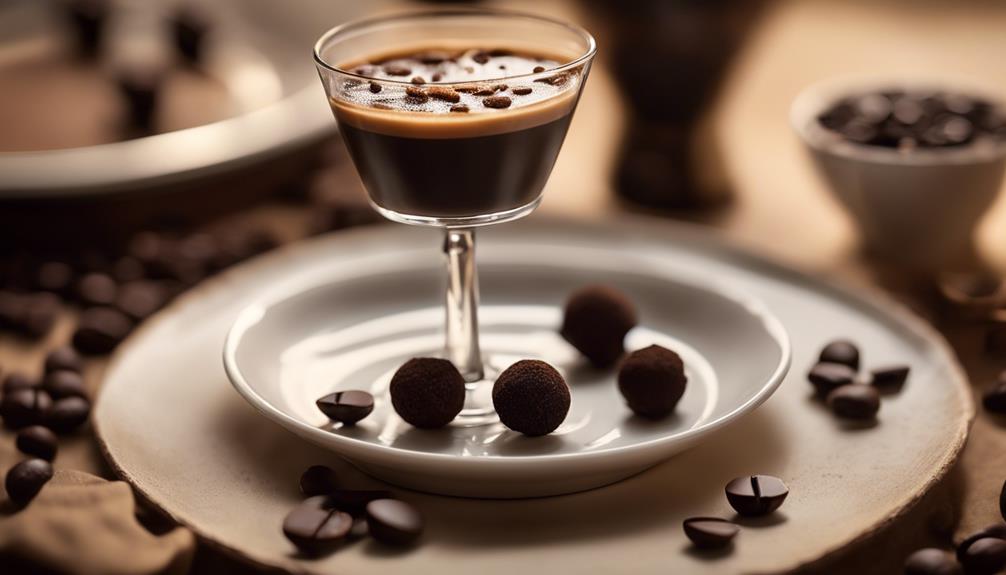
Your Espresso Martini packs a nutritional punch, containing approximately 236 calories per serving, which can impact your dietary choices. This indulgent cocktail is a treat, but it's vital to be mindful of the calories, especially if you're watching your weight. With 24g of carbohydrates and 24g of sugar, it's important to balance it with healthier options.
However, the good news is that you can adjust the nutritional values by using different coffee liqueurs or sweeteners.
When it comes to serving suggestions, your Espresso Martini pairs perfectly with desserts, enhancing the flavor experience during social gatherings or happy hours. The strong coffee flavor from the fresh espresso and coffee liqueur creates a beautiful balance of indulgence and flavor, making it suitable for both coffee lovers and cocktail enthusiasts.
To take it to the next level, consider garnishing with three coffee beans, not only adding a decorative touch but also symbolizing health, wealth, and happiness in Italian tradition. With these serving suggestions, you'll be ready to impress your friends at your next happy hour or dinner party.
History and Cultural Significance
The Espresso Martini's rich history dates back to the late 1980s, when bartender Dick Bradsell crafted this iconic cocktail at the Soho Brasserie in London. You might be surprised to learn that the drink was inspired by a model's request for a drink that would "wake her up and then f*** her up." This unique combination of vodka, coffee liqueur, and freshly brewed espresso reflects the growing popularity of coffee-infused drinks in the bar scene.
Here's a breakdown of the Espresso Martini's cultural significance:
| Aspect | Description |
|---|---|
| Creation | Late 1980s, Soho Brasserie, London |
| Inspiration | Model's request for a energizing drink |
| Flavors | Vodka, coffee liqueur, freshly brewed espresso |
| Garnish | Three coffee beans, symbolizing health, wealth, and happiness |
| Popularity | Resurgence in recent years, trendy staple in bars worldwide |
As you enjoy your Espresso Martini, remember that it's not just a delicious drink, but also a symbol of elegance and energy. The traditional garnish adds a layer of cultural significance, making it a perfect choice for social gatherings and pre-dinner cocktails.
Frequently Asked Questions
What Is in a Traditional Espresso Martini?
You're wondering what's in a traditional espresso martini? It's a combo of vodka, freshly brewed espresso, coffee liqueur like Kahlua, and a touch of simple syrup, all working together to create a rich, velvety drink.
Who Made the Original Espresso Martini?
You're wondering who's behind the buzz of the iconic Espresso Martini? It's none other than Dick Bradsell, a London bartender who created it in the late 1980s to satisfy a model's provocative request!
What Coffee Is Best for Espresso Martini?
When making an Espresso Martini, you'll want to use high-quality, freshly brewed espresso from medium to dark roast coffee beans for a rich, bold flavor that complements the sweetness of the liqueur and vodka.
What Vodka Is Best for Espresso Martini?
Did you know 75% of vodka drinkers prefer premium brands? When choosing a vodka for your Espresso Martini, you should opt for a smooth, high-quality brand like Grey Goose or Belvedere to maintain elegance and flavor.
Conclusion
You've now mastered the original espresso martini recipe, a classic that's sure to impress!
As you raise your glass, remember that over 3.2 billion cups of coffee are consumed daily worldwide, making your crafty creation a part of a rich global tradition.
With every sip, you're not only savoring a delicious drink but also connecting with a vibrant cultural heritage that spans centuries.
Cheers to that!
